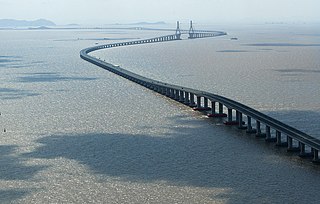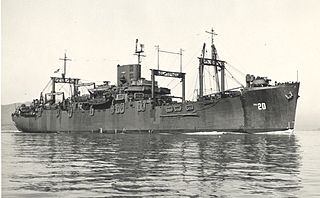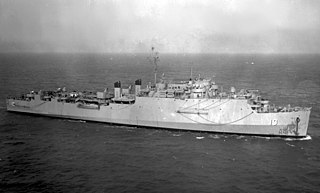
USS Fletcher (DD/DDE-445), named for Admiral Frank Friday Fletcher, was the lead Fletcher-class destroyer, and served in the Pacific during World War II. She received fifteen battle stars for World War II service, and five for Korean War service.

The second USS Menhaden (SS-377) was United States Navy Balao-class submarine. Launched in 1944, she operated out of Pearl Harbor until 1946, then continued in use out of various ports in the Pacific until the 1970s. She was then decommissioned and re-fitted as a remotely controlled, unmanned acoustic test vehicle known as the "Yellow Submarine", until she was scrapped in 1988.

Roll-on/roll-off ships are cargo ships designed to carry wheeled cargo, such as cars, trucks, semi-trailer trucks, buses, trailers, and railroad cars, that are driven on and off the ship on their own wheels or using a platform vehicle, such as a self-propelled modular transporter. This is in contrast to lift-on/lift-off (LoLo) vessels, which use a crane to load and unload cargo.

Trieste II(DSV-1) was the successor to Trieste—the United States Navy's first bathyscaphe purchased from its Swiss designers.

USS Kidd (DD-661), a Fletcher-class destroyer, was the first ship of the United States Navy to be named after Rear Admiral Isaac C. Kidd, who died on the bridge of his flagship USS Arizona during the 1941 Japanese attack on Pearl Harbor. Admiral Kidd was the first US flag officer to die during World War II, and the first American admiral ever to be killed in action. A National Historic Landmark, she is now a museum ship, berthed on the Mississippi River in Baton Rouge, Louisiana, and is the only surviving US destroyer still in her World War II configuration.

USS Pringle (DD-477), a Fletcher-class destroyer, was a ship of the United States Navy named for Vice Admiral Joel R. P. Pringle (1873–1932).

USS Halford (DD-480), a Fletcher-class destroyer, was a ship of the United States Navy named for Lieutenant William Halford (1841–1919), a recipient of the Medal of Honor.

Donghai Bridge is a Chinese bridge counted among the longest cross-sea bridges in the world. It was completed on December 10, 2005. It has a total length of 32.5 kilometres (20.2 mi) and connects mainland Shanghai's Pudong New Area with the offshore Yangshan Deep-Water Port in Zhejiang's Shengsi County. Most of the bridge is a low-level viaduct. There are also cable-stayed sections to allow for the passage of large ships, the largest with a span of 420 metres (1,380 ft). Donghai Bridge is part of the S2 Hulu Expressway.

Yangshan Port, formally the Yangshan Deep-Water Port, is a deep water port for container ships in Hangzhou Bay south of Shanghai. The port is part of the Maritime Silk Road. The port is built on the islands of Greater and Lesser Yangshan, part of the Zhoushan archipelago, with fill from land reclamation. Connected to Shanghai's Pudong New Area by the Donghai Bridge and forming part of the Port of Shanghai, the islands of Greater and Lesser Yangshan are administered separately as part of Zhejiang's Shengsi County.

HMAS Diamantina (K377/F377/A266/GOR266), named after the Diamantina River in Queensland, is a River-class frigate that served the Royal Australian Navy (RAN). Constructed in the mid-1940s, Diamantina was active from 1945 until 1946, was placed in reserve, then was recommissioned as a survey ship from 1959 until 1980.

USS President Hayes (APA-20) was a President Jackson-class attack transport that saw service with the US Navy in World War II. It was named for Rutherford B. Hayes, 19th U.S. president.

An amphibious assault ship is a type of amphibious warfare ship employed to land and support ground forces on enemy territory by an amphibious assault. The design evolved from aircraft carriers converted for use as helicopter carriers. Modern ships support amphibious landing craft, with most designs including a well deck. Coming full circle, some amphibious assault ships also support V/STOL fixed-wing aircraft, now having a secondary role as aircraft carriers.

A heavy-lift ship is a vessel designed to move very large loads that cannot be handled by normal ships. They are of two types:

USS Comstock (LSD-19) was a Casa Grande-class dock landing ship of the United States Navy. She was the first navy ship named in honor of the Comstock Lode in Nevada, discovered in 1859, which was one of the richest deposits of precious metals known in the world.

USS Navasota (AO-106) was an Ashtabula-class replenishment oiler that served in the U.S. Navy from 1946 to 1973, then transferred to the Military Sealift Command to continue service as United States Naval Ship USNS Navasota (T-AO-106) until taken out of service in 1992. Navasota was sold for scrapping in 1995. She was the only U.S. Navy ship to bear the name Navasota.
USS Muscatine (AK-197) was an Alamosa-class cargo ship that was constructed for the US Navy under a US Maritime Commission contract during the closing period of World War II. She had a brief and successful career before being decommissioned a year later.

The 868th Tactical Missile Training Squadron is an inactive unit of the United States Air Force. Its last assignment was with the 868th Tactical Missile Training Group, at Davis Monthan Air Force Base, Arizona, where it conducted training with the BGM-109G Gryphon. It was inactivated on 31 May 1990.

HMS Guysborough was a VTE-engined Bangor-class minesweeper of the Royal Navy. Before commissioning she was transferred to the Royal Canadian Navy on loan. She saw action in the Battle of the Atlantic and the Invasion of Normandy. She was torpedoed by the German submarine U-868 in 1945 while returning to the United Kingdom.
Type 071 icebreaker with NATO reporting name Yanha (延哈) class is the first generation icebreaker indigenously developed in China for the People's Liberation Army Navy (PLAN). A total of three was built and the last unit remain active in PLAN service.
HMCS Quinte was a Bangor-class minesweeper constructed for the Royal Canadian Navy during the Second World War. The ship entered service in 1941 and took part in the Battle of the Atlantic. On 30 November 1942, Quinte ran aground and sank off Cape Breton Island. The ship was re-floated and repaired and spent the rest of the war as a training ship. Following the war, the minesweeper was used for naval research until decommissioned in 1946. The vessel was sold for scrap and broken up in 1947.
















